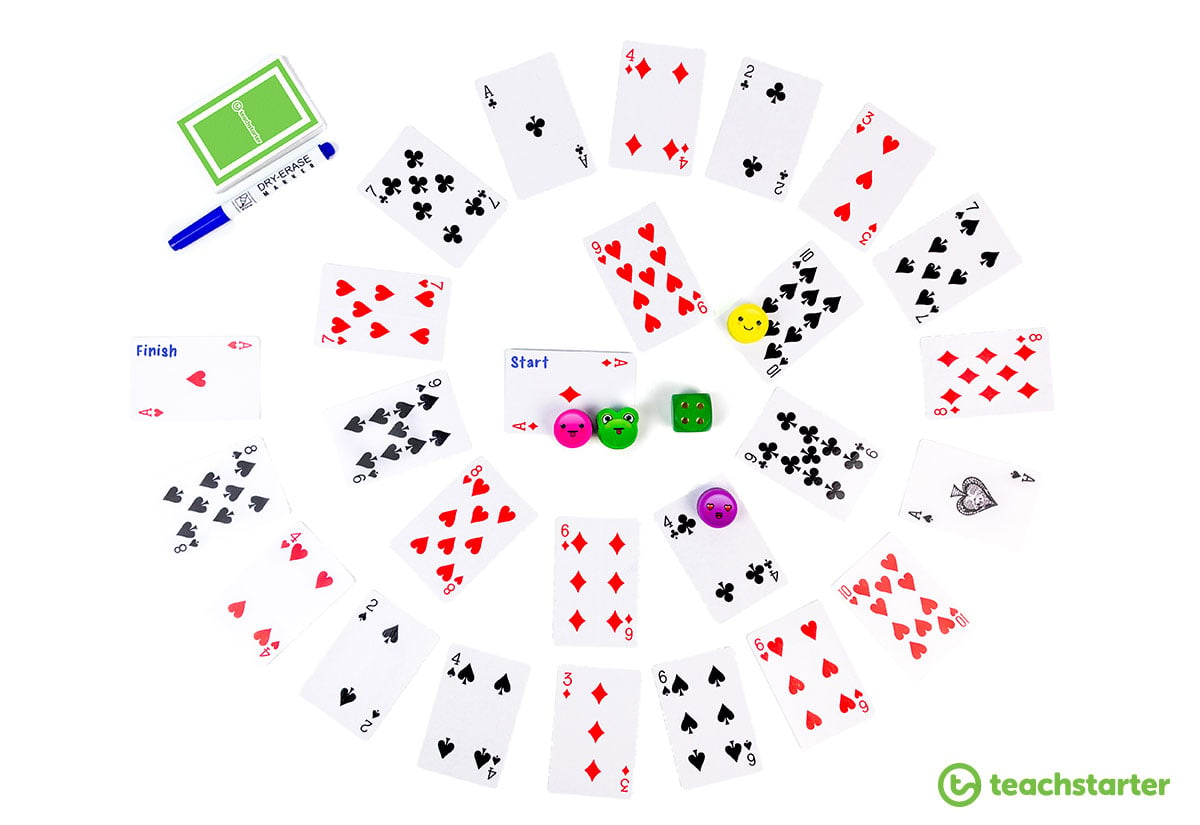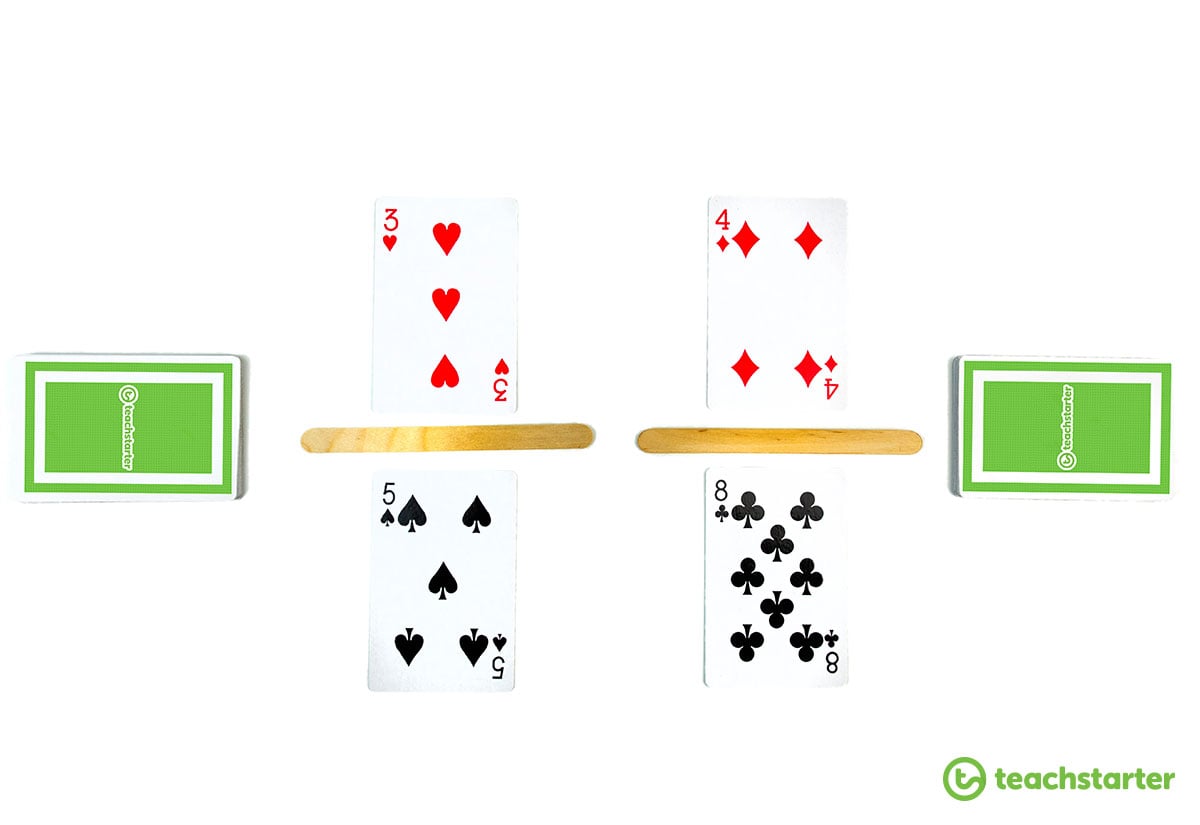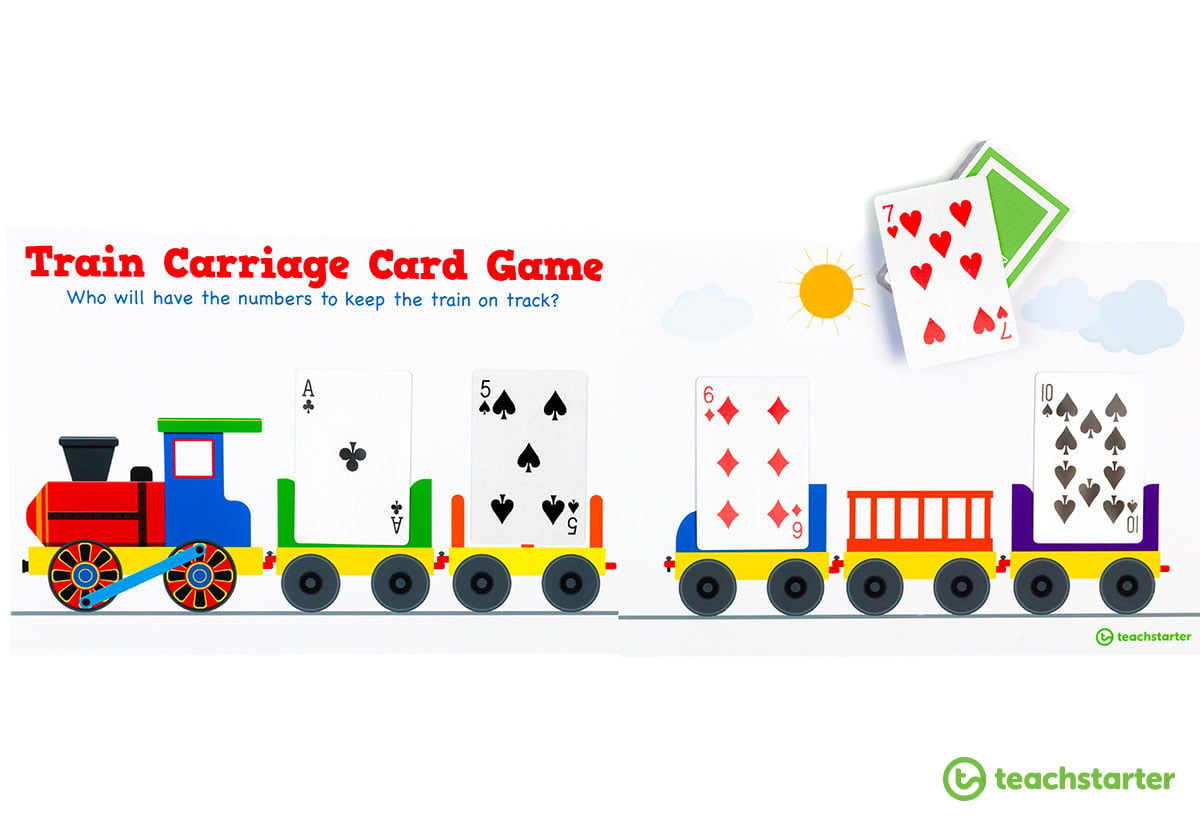Using a deck of cards for games and activities in the classroom is a fun learning experience for children, and cheap and easy for teachers! In my classroom, I would often use some of these games and activities as warm-ups to begin my maths block.
Make 10 pyramid game

This activity can be an individual activity, such as solitaire. Alternatively, it can be played by more than one player by keeping score after each round. A great fast fact game that kids enjoy playing!
Aim – To remove as many cards as possible from the pyramid that add up to 10.
How to play
- Remove all face cards except the Ace – this is the number 1.
- Create a pyramid shape with 6 rows (like the photo above). Each row should slightly overlap the previous row.
- The remaining cards become the draw pile.
- The object of the game is to remove cards that ‘make 10’. Students can remove one card (being a 10) or remove two cards that add up to 10.
- The cards that are removed must be completely uncovered. Therefore, at the start of the game you can only remove cards that are in the bottom row.
- The cards that add up to 10 are placed in a discard pile off to the side.
- If a player can not make 10 with any of the uncovered cards in the pyramid, they need to draw a card from the draw pile and can use this card to ‘make 10’. If they still can’t make 10 they continue to draw until they can make 10.
- If the draw pile runs out, a player can shuffle the discard pile and draw from there.
- The game is over when a player can no longer remove cards from the pyramid.
- If playing against each other, the player’s score is the total of all the cards left in their pyramid. The person with the smallest number wins that round.
Differentiation – Provide younger students visual reminder of the numbers that ‘make 10’ such as our rainbow facts poster.
Number sentence activity

Great activity to consolidate students’ knowledge of number sentence structure.
Aim – To create number sentences when provided with two numbers.
Equipment
- blank laminated board
- whiteboard marker
- whiteboard eraser
- 1 pack of cards
How to play
- Remove the face cards and place the pack of cards face down.
- Students select two cards.
- Students then create a correct number sentence using the two cards they have picked.
- They write the additional number and symbols on their laminated board.
- To create an element of fun, time the students. See who can create their number sentence the fastest.
Differentiation – Have students use a harder operation or add in the face cards and give them numbers such as: Jack – 11, Queen – 12 and King – 13.
Addition or subtraction battle

A great game for 2-4 players to consolidate fast fact recalling.
Aim – To add or subtract simple sums to win as many cards as possible.
Equipment
- 1 pack of cards
- 1 dice
How to play
- Take out the face cards except Ace – this will be number 1.
- Shuffle the cards and deal the cards evenly among the players.
- One player throws the dice.
- Each player then flips up one card from their pile of cards.
- If playing addition battle, each player adds the number of their card with the number rolled on the dice, the highest total wins the cards that have been flipped over.
- If playing subtraction battle, the lowest value wins.
- The player that is left with cards wins!
Differentiation – Have students multiply the numbers.
Multiplication spiral game

A fun game to be played by 2-4 players to consolidate multiplication facts.
Aim – to use multiplication facts to get to the finish of the spiral board first.
Equipment
- 1 dice
- 1 pack of cards
- 4 game pieces
How to play
- Take out the face cards except Ace – this will be number 1.
- Shuffle the cards and create a spiral shape.
- Stick the word start on the middle card and finish on the last card.
- Students place game pieces (like any other board game) at the start.
- The students then take in turns to roll the dice.
- Once they have a number showing on the dice they multiply this number by the number on the card their game piece is on.
- If they are correct, the can move the number of spaces on the dice. If they are incorrect, they miss a turn.
- The player that gets to the ‘finish’ first is the winner!
Place value activity or game
A great activity to consolidate students’ knowledge of place value.
Aim – To create the largest number possible with 3 or 4 numbers.
Equipment
- Teach Starter place value mat
- 1 pack of cards
How to play
- Take out the face cards, shuffle and place the cards face down.
- Students then pick three or four cards depending on their skill level.
- They must then create the largest number they can using the numbers.
- To turn it in to a game, provide each student with a place value mat and deal out the cards.
- At the same time, each student picks three or four cards from their pile of cards.
- The student that can make the largest number wins!
Differentiation – Students can use place value mats with just tens and ones or for a harder activity use thousands, hundreds and ones.
Make 40 game

A great game to improve fast addition skills.
Aim – To add numbers until the total gets to 40.
How to play
- Take out the face cards and shuffle the cards.
- Deal out the cards to the players.
- The first player turns over their top card and places it in the middle.
- The next player turns over their top card and places it on the first card. This player adds the value of the two cards and tells everyone the total.
- The next player does the same, adding the value of their card to the previous total.
- Play continues until the total reaches 40 or over. The player who puts down the card that takes the total to 40 or over takes all of the cards and shuffles them in with their remaining cards.
- Play continues until set time or when one player has no cards left.
- The winner is the person with the most cards.
Differentiation – Have students add to 20 or for a harder activity you may like to get them to add till they get to 100.
20 questions number hat activity

Kids love this! Create a hat with a space that will fit a card. I just used a strip of yellow card and glued a rectangle shape to the front. You will need a blob of blue tack so that the card can easily be changed.
Aim – To work out the number by asking 20 or less questions.
How to play
- Take out the face cards except Ace – this will be number 1.
- The student picks a card without looking and places it on their ‘guessing hat’ using the blue tack.
- The student then has 20 questions to work out what number they have.
- The questions they ask can only be answered by the rest of the group or class with a ‘yes’ or ‘no’.
Differentiation – Have students pick two cards to create a 2 digit number.
Fraction and addition draw game

A great game where students create and compare fractions. Best played in pairs.
Aim – to create and compare fractions, ultimately being lucky enough to pick and create the largest fraction.
How to play
- Take out the face cards except Ace – this will be number 1.
- Shuffle the cards and place them face down in the middle of the players
- Each player draws two cards from the pile and creates their own fraction.
- The smallest value must be placed at the top of their fraction.
- The fractions are then compared and the player with the largest fraction wins that round and gets to keep their cards.
- The other players must return their cards to the bottom of the pile of cards.
- Each player keeps adding the value of the cards they have won until one player reaches 50 – they are the winner!
Train carriage card game
A great early years number game for 2-4 players to consolidate the knowledge of simple sequencing of numbers.
Aim – To sequence numbers from smallest to largest along the train carriages. The winner is the last person to place a card on the train.
Equipment
- 1 pack of cards
- 1 train template
How to play
- Using our train carriage template and a deck of cards.
- Take out the face cards except Ace – this will be number 1.
- Shuffle and place the deck of cards face down next to the train.
- The first player picks up a card from the top of the pile and decides where it would best fit on the train carriages. For example, if they picked up a number 9 card, it is one of the largest numbers so the player may choose to put this on the last carriage in the train.
- The next player then picks up a card and decides the best carriage for their card, if they pick up a 10, and the last carriage has been taken by another card, they miss a turn and place their card at the bottom of the deck of cards.
- Play continues until all of the train carriages are full. The winner is the last person to place a card on the train.
Differentiation – Add more carriages or change the number sequence pattern or include factors of a number order.
We hope these activities and games have inspired you to go out and buy a few decks of cards! Have you got any other ideas or activities to use in the classroom with a deck of cards? Let us know in the comments below…









I LOVED this blog - just what I was looking for to set up warm ups and hands on maths games for rotations. Thank you :)
Thanks so much for the kind words, Emma! We hope your class enjoy them!
Great games, i would like to print of rules to put in Maths rotation centres. Is that possible?
Hi Sue, Thanks for your suggestion. Please feel free to request a resource here: https://www.teachstarter.com/request-a-resource/ Requests are voted on by the Teach Starter community. We create the top request each week. Please let me know if you have any further questions, I'm more than happy to help. Kind regards, Kristian